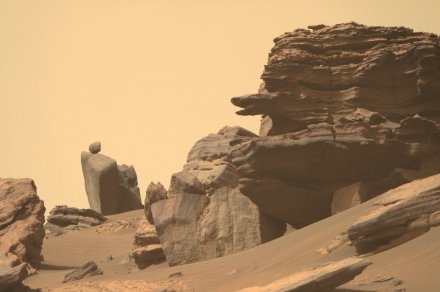
A team of NASA scientists has suggested that Mars rovers may have to dig deeper than first thought to give them the best chance of finding evidence of ancient microbial life on the distant planet.
Recent research carried out by the team found that cosmic rays from the sun degrade small molecules such as amino acids — the fundamental building blocks of life — at a much faster rate than expected. The existence of certain amino acids are key in scientists’ quest to prove that microbial life once existed on Mars.
“Our results suggest that amino acids are destroyed by cosmic rays in the martian surface rocks and regolith at much faster rates than previously thought,” said Alexander Pavlov of NASA’s Goddard Space Flight Center in Greenbelt, Maryland. “Current Mars rover missions drill down to about 2 inches (around 5 centimeters). At those depths, it would take only 20 million years to destroy amino acids completely.”
Since scientists are searching for evidence of life on Mars from billions of years ago when the planet was more like Earth, the material collected from these shallow depths may not be as useful as first thought. Earth’s thick atmosphere and global magnetic field shields the planet from most cosmic rays, but Mars lost this protection billions of years ago. During the time when it did have a thicker atmosphere, the red planet contained liquid water. “Since liquid water is essential for life, scientists want to know if life emerged on Mars and search for evidence of ancient martian life by examining Mars rocks for organic molecules such as amino acids,” NASA said.
The scientists’ findings suggest that martian rock samples will have to be extracted from a depth of about 6.6 feet (2 meters), where any such evidence should remain intact.
As NASA’s Perseverance rover can only drill down a few inches, the development could prompt the team behind the current Mars mission to adopt a new strategy for the rover, which has been gathering rock samples on the red planet for the last 10 months.
A workaround suggested by the scientists involves extracting samples from exposed outcrops such as microcraters that are less than 10 million years old, or from the material ejected by impacts involving these craters.
The space agency also points out that although amino acids have yet to be found on Mars, they have been located within meteorites, including one from the red planet. “We did identify several straight-chain amino acids in the Antarctic Martian meteorite RBT 04262 in the Astrobiology Analytical Lab at Goddard that we believe originated on Mars (not contamination from terrestrial biology), although the mechanism of formation of these amino acids in RBT 04262 remains unclear,” said NASA Goddard’s Danny Glavin, who was also involved in the recent research. “Since meteorites from Mars typically get ejected from depths of at least 3.3 feet (one meter) or more, it is possible that the amino acids in RBT 04262 were protected from cosmic radiation.”
NASA’s Jet Propulsion Laboratory, which is overseeing the current Mars mission, has yet to respond to the findings. Perseverance has already collected a number of samples for later return to Earth so that scientists can analyze the material in cutting-edge laboratories. However, the team may now redirect the rover to the kind of locations cited in the scientists’ research.
Editors’ Recommendations
Credit: Source link


Comments are closed.